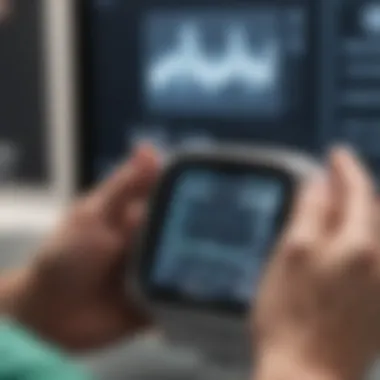The Importance of ABPM in Modern Healthcare


Intro
Ambulatory Blood Pressure Monitoring (ABPM) has shifted the paradigm in how healthcare professionals assess and manage hypertension. Traditional methods often yield inconsistent results due to various factors, including patient anxiety and one-time readings. ABPM addresses these limitations by providing a more comprehensive view of a patient’s blood pressure throughout a 24-hour cycle. This continuous monitoring captures fluctuations that occur during daily activities, offering insights that a single measurement cannot provide.
The relevance of ABPM in modern healthcare is underscored by its potential to improve patient outcomes and enhance the accuracy of hypertension diagnoses. In the ensuing sections, this article delves into the operational mechanics of ABPM, its advantages, its applications in clinical settings, and guidelines for optimal use.
Intro to ABPM Blood Pressure Monitors
Ambulatory Blood Pressure Monitoring (ABPM) has emerged as a vital tool in the management of cardiovascular health. Understanding ABPM is crucial as it enhances the accuracy of blood pressure measurements and allows for comprehensive monitoring over extended periods. In traditional practice, blood pressure readings taken in a clinic can be susceptible to various biases, such as anxiety or white coat syndrome. ABPM seeks to mitigate these concerns by capturing readings during normal daily activities.
ABPM is invaluable in diagnosing hypertension, monitoring treatment effectiveness, and providing insights into patients' blood pressure patterns. Furthermore, the relevance of ABPM extends into integrating technology in healthcare, reflecting a shift towards patient-centered care.
Definition and Overview
Ambulatory Blood Pressure Monitoring refers to a technique that measures blood pressure at regular intervals over a period, often 24 hours. During this time, patients engage in their usual activities while wearing a portable device. This device inflates and deflates a cuff attached to the patient’s arm at set intervals, recording blood pressure readings continuously.
The primary advantage of ABPM is that it provides a more accurate representation of a patient's blood pressure in a real-world setting. Unlike the static measurements taken in a clinical setting, ABPM captures fluctuations that occur throughout daily life. This method enables healthcare professionals to identify not just average blood pressure levels but also variability and potential episodes of hypertension that might go unnoticed in a clinical environment.
Historical Development
The development of blood pressure monitoring techniques has a storied history. Initially, blood pressure was assessed using basic instruments that provided only single, static measurements. In the mid-20th century, the understanding of hypertension evolved, leading to the introduction of portable devices.
By the 1980s, advancements in technology allowed for the creation of automated ABPM devices. These units became smaller, more user-friendly, and more accurate, paving the way for widespread adoption in clinical practice. This shift was not just technological but also conceptual, with a growing recognition of the need for continuous monitoring in managing hypertension effectively. Today, ABPM is regarded as a gold standard for diagnosing high blood pressure, reaffirming its role in modern healthcare.
Mechanics of Blood Pressure Monitoring
Blood pressure monitoring is fundamental to understanding cardiovascular health. The mechanics of this process have evolved significantly, particularly with the introduction of Ambulatory Blood Pressure Monitoring (ABPM). This section explores the various technical aspects and operational functions of ABPM, emphasizing its significance in modern healthcare.
Technical Specifications
Ambulatory Blood Pressure Monitors are designed with specific technical features that enhance their effectiveness. Unlike traditional sphygmomanometers, ABPM devices are portable and can record blood pressure at set intervals, typically every 15 to 30 minutes. These devices usually include:
- Cuffs that are adjustable to fit different arm sizes, ensuring accurate readings.
- Sensors that detect blood flow and pressure changes, allowing for real-time data collection.
- Data storage capabilities that can hold results for analysis over a 24- or 48-hour period.
- Software integration, which allows for precise data analysis and visualization.
The compact design and user-friendly interface also play a crucial role. These specifications enable patients to go about their daily routines without significant disruption, gathering data in natural settings. This capability is imperative for capturing variations in blood pressure that may be missed during an office visit.
How ABPM Functions
ABPM operates by measuring blood pressure at predefined intervals throughout the day and night. The process begins with the device being fitted to the patient, usually on the upper arm. Once activated, the monitor inflates the cuff automatically, measuring the blood pressure during both systolic and diastolic phases. The readings are taken while the patient continues normal activities, which is a stark contrast to traditional methods.
Key functional elements include:
- Automated Measurements: The device takes blood pressure measurements without the need for the patient's active involvement, reducing bias.
- Circadian Rhythm Monitoring: ABPM helps in identifying the diurnal variations in blood pressure, which can inform diagnosis.
- Data Downloading: After the monitoring period, the data can be transferred to a computer or mobile device for detailed analysis. This feature helps healthcare providers make informed decisions based on comprehensive data rather than isolated readings.
"ABPM offers a dynamic approach to blood pressure monitoring, capturing real-world data crucial for accurate diagnoses."
This ensures a significant advancement over traditional monitoring practices and supports the move towards more personalized and effective patient care.
Comparison with Traditional Methods
Understanding the differences between Ambulatory Blood Pressure Monitoring (ABPM) and traditional blood pressure measurement is vital. The use of ABPM has grown due to its ability to provide a more accurate representation of a patient’s blood pressure over a longer time period. This section discusses the key distinctions, benefits, and considerations of both methods to explain why ABPM holds a prominent position in modern healthcare.
Ambulatory Monitoring vs. In-Office Measurements


Ambulatory Blood Pressure Monitoring, unlike traditional in-office measurements, involves continuous monitoring of blood pressure throughout a 24-hour period. During this time, the device records blood pressure at regular intervals. This method captures fluctuations in blood pressure that may occur due to daily activities, sleep, and stress, which single measurements cannot provide.
In contrast, traditional methods involve measuring blood pressure in a clinical setting, often during a short visit to a healthcare provider. These readings may lack context since they do not factor in the patient’s everyday life or anxiety levels associated with medical visits.
Patients with white coat syndrome, which is characterized by elevated blood pressure readings in clinical settings, may be misdiagnosed with hypertension when in fact their pressure is normal during daily life. ABPM helps to alleviate these concerns. Moreover, the data collected through ABPM is often used to make more informed decisions regarding a patient’s treatment plan.
Advantages and Disadvantages
The choice between ABPM and traditional methods comes with both advantages and disadvantages. Understanding these can influence healthcare providers’ decisions.
Advantages of ABPM:
- Greater Accuracy: Offers a comprehensive view of blood pressure patterns.
- Diagnostic Capability: Essential for diagnosing conditions like masked hypertension.
- Patient Engagement: Promotes involvement in monitoring their health status efficiently.
Disadvantages of ABPM:
- Comfort Issues: Some patients may find wearing the monitor inconvenient.
- Cost Considerations: ABPM devices can be more expensive than traditional sphygmomanometers.
- Technical Challenges: There can be issues with device calibration or maintenance that affect readings.
In summary, while traditional in-office measurements provide quick and easy assessments, ABPM advantages of capturing a full picture of a patient's blood pressure dynamics ultimately enhance diagnostic accuracy. As healthcare continues to advance, integrating both methods into patient care protocols will be essential for optimal health outcomes.
Clinical Applications of ABPM
Ambulatory Blood Pressure Monitoring (ABPM) plays a crucial role in modern healthcare by extending the capabilities of blood pressure assessment beyond static clinic visits. Understanding the clinical applications of ABPM is essential for healthcare professionals looking to enhance patient care and improve diagnostic accuracy. The use of ABPM allows for a more comprehensive and dynamic view of a patient's blood pressure patterns, revealing important trends that stationary measurements might miss.
Diagnosis of Hypertension
Hypertension is a significant public health concern. Traditional methods of measuring blood pressure often fall short of providing a complete picture. ABPM offers a distinct advantage here. By collecting blood pressure data over 24 hours, ABPM can reveal not only average blood pressure levels but also variations throughout the day and night. This is critical for an accurate diagnosis.
Adopting ABPM in diagnosing hypertension can lead to better identification of patients who truly suffer from this condition. Healthcare providers can distinguish between primary and secondary hypertension more effectively with in-depth data. Often, a one-time reading at a clinic can lead to misdiagnosis, a problem ABPM seeks to rectify. This point highlights the necessity of implementing ABPM into routine diagnostic pathways.
Monitoring Treatment Efficacy
ABPM is an invaluable tool for assessing how well a treatment works over time. After initiating or adjusting antihypertensive therapy, healthcare providers can utilize ABPM to monitor a patient’s response. This monitoring allows for timely adjustments, ensuring that the chosen treatment is effective in maintaining target blood pressure levels.
Through repeated ABPM assessments, clinicians can gather robust data concerning fluctuations in blood pressure in response to medications. This method promotes a tailored approach to treatment, helping to prevent complications associated with both under-treatment and over-treatment.
Identifying White Coat Hypertension
White coat hypertension is a phenomenon where patients present elevated blood pressure readings in a clinical setting due to anxiety, while their readings are normal at other times. ABPM serves as an effective means to identify this condition, allowing healthcare providers to differentiate between true hypertension and temporary spikes caused by stress.
Through extended monitoring away from the clinical environment, ABPM can help in understanding a patient's baseline behavior under normal circumstances. Identifying white coat hypertension can significantly reduce unnecessary medication and associated side effects for patients whose blood pressure readings are misleading. It also facilitates better patient education regarding their true cardiovascular status, helping to reduce anxiety associated with typical medical evaluations.
ABPM thus stands as a vital tool in diagnosing hypertension, monitoring treatment progress, and identifying cases of white coat hypertension. Healthcare professionals looking to enhance their diagnostic precision and tailor treatment plans should consider implementing ABPM as a standard practice.
"Understanding blood pressure dynamics through ABPM enhances overall patient care and outcomes."
Integrating ABPM into clinical routines represents a step forward in hypertension management, reinforcing the need for continuous learning and adaptation in healthcare practices.
Guidelines and Best Practices
Who Should Use ABPM?
The application of Ambulatory Blood Pressure Monitoring (ABPM) is relevant for a diverse group of patients. Primarily, individuals diagnosed with hypertension can greatly benefit from this method. This includes those with resistant hypertension, where conventional treatments have not proven effective. Also, patients who frequently experience fluctuations in blood pressure readings may find ABPM advantageous. The continuous data collection allows for more accurate assessments than sporadic in-office measurements.
Additionally, those suspected of having white coat hypertension should consider ABPM. This condition occurs when patients exhibit elevated blood pressure in clinical settings but not in everyday life. Employing ABPM can confirm or rule out this diagnosis, improving the management strategy tailored for the patient.


Physicians may also recommend ABPM for evaluating the effectiveness of prescribed antihypertensive therapy. By analyzing blood pressure patterns over a 24-hour period, doctors can better understand how a patient's blood pressure responds to medications, ultimately leading to optimized treatment.
Interpreting ABPM Results
Understanding the results from ABPM requires careful consideration. The average blood pressure readings over the monitoring period are central to the interpretation. Results typically reveal systolic and diastolic pressures, alongside the percentage of time spent above or below certain thresholds. Clinicians should assess whether the patient’s blood pressure normalizes outside of clinical settings and how nocturnal readings assess nighttime blood pressure control.
A critical aspect also includes recognizing the day-night ratio. Normally, blood pressure should dip during sleep compared to daytime levels. Failure to reach this nightly dip may suggest the presence of masked hypertension or increased cardiovascular risk.
Moreover, ABPM provides insight into the patient’s blood pressure variability. High variability could indicate poorer outcomes, necessitating a closer look at treatment regimens. As the data can be overwhelming, it is essential to streamline results in a user-friendly format, possibly with visual aids.
Integrating ABPM into Patient Care
Incorporating ABPM into routine patient care hinges on a structured approach. First, healthcare providers must establish clear indications for ABPM use. This can include the initial diagnosis of hypertension, assessing treatment effectiveness, and monitoring potential complications.
Communication with patients is vital for seamless integration. Before the monitoring process, educate the patient on the procedure. This helps in alleviating anxiety and ensuring compliance. Encourage patients to maintain their regular routines during monitoring for the most accurate readings.
Following the monitoring phase, healthcare providers should discuss findings with the patient in a comprehensive manner. Analyzing trends in the data can lead to informed decisions about treatment adjustments. This ongoing dialogue builds trust and empowers patients to engage in their health management.
Effective integration also requires collaboration among healthcare teams. Specialists, nurses, and general practitioners should work together to share insights from ABPM data. A unified approach can enhance patient outcomes and foster a more precise management of hypertension.
In summary, the thoughtful integration of ABPM into patient care enhances the quality of hypertension management through precise, individualized treatment plans and open communication with patients.
Technological Advances in ABPM
Technological advances in Ambulatory Blood Pressure Monitoring (ABPM) play a pivotal role in enhancing our understanding of blood pressure dynamics. The integration of modern technologies has improved the accuracy and utility of these monitors in clinical settings. As healthcare providers strive to provide effective patient care, these advancements help streamline blood pressure monitoring processes and foster better patient outcomes.
Emerging Technologies in Blood Pressure Monitoring
Recent developments in ABPM technology have resulted in devices that are more accurate, user-friendly, and capable of providing a wealth of data over extended periods.
- Wireless Connectivity: Many devices now feature wireless data transmission. This allows healthcare providers to access patient readings in real-time. It enhances collaboration between the physicians and patients.
- Miniaturization: The trend towards smaller devices means that patients can wear monitors without significant discomfort. Modern ABPM devices are often lightweight and portable, which encourages compliance and ease of use.
- Enhanced Algorithms: Advanced algorithms enhance the detection of hypertension by analyzing the data collected during monitoring. These algorithms can account for variations in individual blood pressure patterns and provide more tailored insights into the patient’s condition.
- Integration with Other Sensors: Emerging blood pressure monitors often incorporate additional sensors, such as heart rate monitors, which allow for a more holistic view of a patient's cardiovascular health.
"Innovations in ABPM technology are not merely improving measurement accuracy; they also promote a comprehensive understanding of patient health."
Impact of Digital Health Tools
The introduction of digital health tools in ABPM represents a significant shift in how blood pressure monitoring is performed and interpreted.
- Mobile Applications: Many devices now come with companion mobile apps that allow patients to track their blood pressure data. These apps can provide reminders for monitoring and enable users to visualize trends over time.
- Telemedicine Integration: The compatibility of ABPM devices with telemedicine applications allows findings to be shared directly during virtual consultations. This can lead to quicker decision-making based on accurate data.
- Data Analytics: The ability to collect and analyze large sets of data can offer healthcare professionals insights into population-level trends in hypertension. This can support better public health initiatives and research.
Potential Challenges and Limitations
The integration of Ambulatory Blood Pressure Monitoring (ABPM) into modern healthcare is indeed groundbreaking. However, it is not without its challenges and limitations. Understanding these factors is crucial to optimizing the use of ABPM in clinical practice. This section discusses the key challenges that may affect patient outcomes and the effectiveness of blood pressure management.
Patient Compliance Issues
Patient compliance is a significant concern when it comes to the effectiveness of ABPM. Unlike traditional office measurements, ABPM requires patients to wear a monitor for an extended period, typically 24 hours. Many patients may feel uncomfortable wearing the device, particularly if it disrupts their daily activities or sleep.
- Time Commitment: Wearing the monitor during waking and sleeping hours can seem burdensome.
- Understanding the Purpose: Patients may not fully grasp the importance of continuous monitoring, leading to reluctance.
- Discomfort: Some individuals experience discomfort due to the size or fit of the cuff.
The lack of proper understanding among patients can lead to incomplete or inadequate data collection. This ultimately hampers the ability of healthcare providers to make informed decisions based on comprehensive blood pressure readings.
Technical Malfunctions


While ABPM devices are designed to be reliable and efficient, they are not immune to technical faults. Malfunctions can lead to incorrect readings or even complete failure of the monitoring process.
Key elements include:
- Device Calibration: Regular calibration is necessary for accurate readings. Neglecting this can result in false data.
- Battery Life: Some monitors may run out of battery during the monitoring period, which interrupts data collection.
- User Error: Incorrect setup or improper use of the device can yield faulty results.
"Monitor failures or incorrect usage can distort the data, making accurate diagnosis challenging."
In summary, while ABPM offers substantial benefits for blood pressure monitoring, challenges related to patient compliance and potential technical malfunctions must be addressed. Addressing these challenges is fundamental to the successful implementation of ABPM in healthcare settings.
Future Directions in ABPM Research
The relevance of Ambulatory Blood Pressure Monitoring (ABPM) in modern healthcare continues to evolve. Research in this field aims to refine techniques, improve accuracy, and integrate advanced technologies. Understanding Future Directions in ABPM Research is crucial for clinicians and researchers alike. This area delves into emerging innovations and the potential role of artificial intelligence in enhancing patient care and monitoring efficacy.
Innovations in Monitoring Techniques
Recent advancements in monitoring techniques focus on increasing the precision of blood pressure readings and enhancing user experience. New cuffs are being designed to be more comfortable, ensuring that patients can wear them without discomfort, thus promoting compliance.
Moreover, wearable technologies are becoming more prominent. Devices that can seamlessly integrate with mobile apps allow for continuous monitoring, providing real-time data reporting. These innovations could lead to better management of chronic conditions like hypertension.
Some notable developments include:
- Smart Cuffs: Devices that adjust to individual arm sizes automatically.
- Wireless Monitoring: Bluetooth-enabled devices for immediate data transfer to healthcare providers.
- Integration with Mobile Health Apps: Allowing patients to track their readings alongside other health metrics.
These innovations not only improve the measurement process but also encourage proactive patient involvement in their own health management.
Potential for Artificial Intelligence Integration
Incorporating artificial intelligence into ABPM offers significant promise. AI can analyze vast quantities of data swiftly, identifying patterns that may not be immediately apparent. This capability can enhance strategies for managing hypertension.
Some potential applications of AI in ABPM research include:
- Predictive Analytics: Offering forecasts about patient health outcomes based on historical data.
- Personalized Monitoring Plans: Tailoring blood pressure management strategies to individual patient profiles and lifestyles.
- Real-time Alerts: Notifying healthcare providers when readings go outside the expected range, allowing for timely interventions.
With advancements in machine learning, the effectiveness of ABPM can be increased. AI can assist in distinguishing between types of hypertension or identifying when patients may require different treatments.
"The integration of AI into ABPM not only improves accuracy but also empowers healthcare providers to make more informed decisions for their patients."
Culmination
The conclusion of this article emphasizes the significance of Ambulatory Blood Pressure Monitoring (ABPM) in modern healthcare. As medical practices evolve, ABPM serves as a pivotal tool for effectively monitoring and managing blood pressure. Health professionals and researchers increasingly recognize its role in providing a more accurate assessment of a patient’s blood pressure levels outside of a clinical setting.
In summary, ABPM helps in diagnosing hypertension and monitoring treatment efficacy, offering insights that traditional methods may miss. Its ability to detect white coat hypertension, a condition where a patient's blood pressure is elevated in a clinical environment but normal at home, showcases its necessity. Moreover, integrating ABPM into regular patient care can improve health outcomes by enabling timely interventions.
The benefits of ABPM extend beyond just blood pressure readings; it also adds value to patient education and adherence to prescribed treatment plans. As healthcare focuses more on personalized medicine, ABPM is set to become a key component in managing hypertension. Its relevance is heightened by ongoing technological advancements and an increased focus on digital health tools, all contributing towards a future where blood pressure monitoring can be more efficient and precise.
"ABPM offers insights into blood pressure patterns, enhancing the quality of care provided to patients and informing better clinical decisions."
The integration challenges faced by ABPM systems will need addressing, yet the overall trend suggests a significant role for these monitors. Healthcare professionals are encouraged to stay informed about the effective use of ABPM, which may shape future clinical guidelines. Learning about ABPM is not merely an academic exercise; it is a necessary step for any healthcare practitioner looking to provide high-quality patient care.
Summary of Key Points
- ABPM allows continuous blood pressure monitoring over 24 hours, providing a comprehensive view of a patient's blood pressure status.
- It effectively identifies white coat hypertension and masked hypertension, which are important for accurate diagnosis.
- ABPM systems enhance treatment efficacy monitoring and improve patient engagement in their health patterns.
- Ongoing research and technological advances will likely increase the efficacy and integration of ABPM in routine healthcare practices.
The Future of ABPM in Healthcare
The direction of ABPM research points towards a more integrated approach within healthcare systems. Innovations in monitoring techniques, such as wireless connectivity and AI-driven analytics, are on the horizon. These technological advancements promise improved accuracy and user-friendliness, which can enhance patient compliance.
As artificial intelligence becomes more embedded in healthcare, the potential for data analytics to predict hypertension-related events may transform ABPM usage. Medical practitioners may access tailored insights, allowing for proactive rather than reactive healthcare approaches.
Further, as digital health tools gain traction, the integration of ABPM into telehealth platforms can foster remote patient management strategies. This capability is essential in expanding reach and ensuring comprehensive care, especially in underserved areas.







